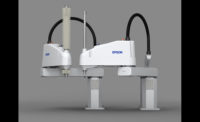Of the various robots used for automated assembly, the Cartesian robot is the least complex. Also known as a rectilinear, rectangular or gantry robot, a Cartesian robot can only move its end effector in straight lines along the X, Y and Z axes. Some Cartesians have an additional axis of motion, in which the end effector rotates about the Z axis or parallel to it.
Cartesians may not be as “sexy” as a high-speed SCARA or a six-axis robot, but that’s also their chief advantage. “In many applications, a SCARA or a six-axis robot would be overkill,” says Brad Klippstein, product manager for Smart Mechatronix at Bosch Rexroth. “You don’t need five or six axes of motion for a simple pick-and-place operation. And, programming a six-axis robot is difficult.
“In contrast, you can program a Cartesian robot in 5 minutes, and it’s easy to make changes to the system.”
With a Cartesian robot, each axis is a separate linear actuator, which can be driven by a ballscrew or belt. Cartesian robots can be built in cantilevered and gantry designs. Which to choose depends on length, velocity, payload and accuracy requirements.
The cantilevered design will limit the range and payload of the robot, because of the torque on the support bearings of the base axis. The greater the payload at the end of the arm, the greater the torque is that is applied to the base axis.
The gantry design overcomes this limitation. Gantry robots move the individual actuators along mutually orthogonal axes. Two parallel linear bearings support the bottom axis and thus eliminate the issue of excessive torque on the base axis. The payload and reach limits of the can easily be extended without having to use oversized linear actuators. The tradeoff for the gantry design is that the open robot work area is now less accessible.
Because a Cartesian robot distributes loads evenly across a rigid frame, it can accurately and repeatably position large payloads at high speeds. Cartesians can come screaming into a position and stop on a dime.
With their modular construction, Cartesian robots are easily scaled to meet various travel and payload needs. Individual axes can be quickly repaired or replaced, and the entire system can be disassembled for use in other motion control applications.
The maximum reach of a SCARA robot is typically 1,000 millimeters. Cartesians are available with travel lengths of 3,000 millimeters or more.
Cartesian robots trade off speed with resolution. The finer the resolution, the slower the resulting speed. Repeatability varies depending on the design. Ballscrew-driven linear actuators typically have better repeatability than belt-driven actuators. Among ballscrew-driven robots, ground screws with anti-backlash ball nuts are generally more accurate and repeatable than rolled ballscrews with standard ball nuts.
The benefit of modularity and customization does not come without a tradeoff. Cartesian robots are harder to move than other robots, and some engineers may not want to assemble, align and coordinate the different axes. Managing the control cables for each axis can be tricky, though new high-speed communication technologies are minimizing this issue. Finally, engineers should beware of making conclusions about the robot’s payload, accuracy or repeatability based on the specifications of one component.
In the past, choosing between Cartesian and SCARA robots was a matter of trade-offs. Cartesians were more accurate and less expensive than SCARAs. SCARAs were faster and took up less space than Cartesians. Today, technological advancements have made the two technologies comparable in both price and performance. As a result, distinctions between the two are much more subtle.
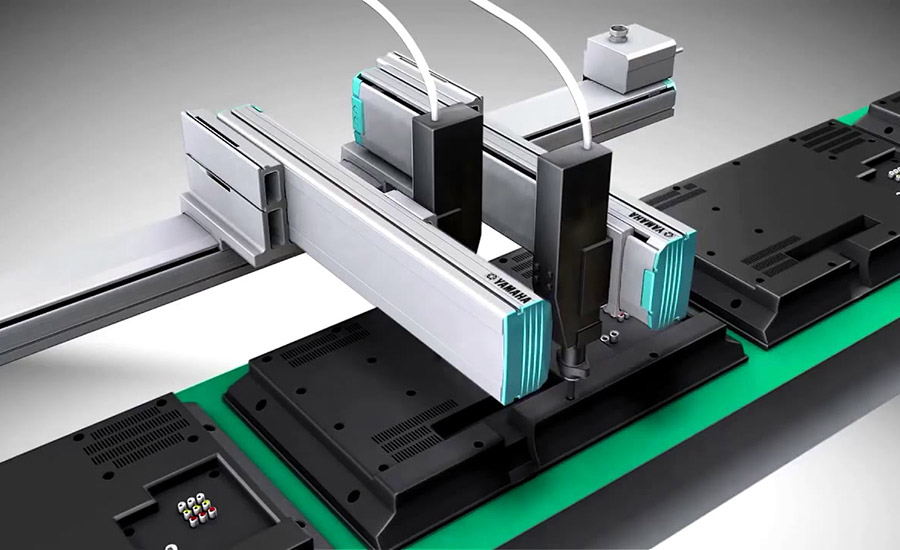
Cartesian robots can be built in cantilevered and gantry designs. Which to choose depends on length, velocity, payload and accuracy requirements. Photo courtesy Yamaha Robotics
One issue to consider is the robot’s work envelope, especially where work space is expensive, such as clean rooms. A SCARA robot’s work envelope is revolute, while a Cartesian’s is rectangular. If you put a revolute work envelope inside a square work area, you can’t use all the available space.
If everything fits in a rectilinear envelope, a Cartesian is good. If the robot must pick up parts at the three o’clock position and bring them over to the 12 o’clock position, a SCARA might be a better option.
Compared with other types of robots, the work envelope of Cartesian robots is well-defined and can easily be visualized. This is helpful if safety guarding will be required. What’s more, the work area of the Cartesian robot is open, so parts can easily be placed in the work area from three sides, including the “front,” where the risk of the operator being struck is minimized.
Cartesian robots can be equipped with a variety of end effectors, including screwdrivers, routers, dispensing valves, soldering heads and grippers. Because of their linear design, Cartesians can inherently carry heavier payloads than comparably sized SCARA or six-axis robots.
When specifying a Cartesian, engineers should provide the weight of the payload—the end effector and any parts it will carry—as well as how far and how fast the payload will travel. This will determine the length and width of the frame and the size of the motors. And, as with any motion control system, accuracy and repeatability requirements are critical.
Duty cycle is another important variable. “Will the robot run twice an hour or will it run continuously for days?” says Klippstein.
Engineers should also specify how and where the robot will be used. If the actuators will be located where maintenance will be difficult, they can be furnished with permanently lubricated bearings. If the robot will be turned off and on frequently, the actuators can be equipped with absolute encoders so the robot won’t have to return to a home position before resuming operation.
Technology Options
Engineers have a wealth of options for Cartesian robots. They can go the do-it-yourself route and build their own custom system from individual linear actuators, or they can buy a standardized Cartesian from a robotics OEM such as Intelligent Actuator, Janome Industrial Equipment, TM Robotics and Yamaha Robotics.
Some companies, such as Ellsworth, Nordson EFD and Techcon, offer tabletop Cartesian robots designed specifically for dispensing adhesives. Others, such as Fancort, Promation and Apollo Seiko, provide tabletop Cartesian systems specifically for soldering.
One of the newest Cartesian systems is the Smart Function Kit for Handling from Bosch Rexroth Corp. The kit is designed to be easy to specify, commission and program, enabling engineers to quickly create and install custom Cartesian handling systems with one, two or three axes of motion.
It all starts with Bosch’s free LinSelect software. The software uses graphical interfaces to guide engineers through the process of inputting system parameters, such as speed, payload and stroke length per axis. The software provides detailed information and choices on performance characteristics, such as repeatability.
Engineers can then put together their own system from standardized components, including actuators, software, drive and motor, with just a few clicks and without any engineering effort. The software provides recommendations for different performance variants and price settings.
Linear actuators are available for moves of 6 inches or 6 feet and payloads as large as 100 kilograms.
Once a design has been picked, engineers can transfer the system data directly to an online configurator and place the order. A CAD model of the system is automatically generated, as well. The system is then shipped fully assembled—actuators, electronics, cabling, drives, motors and software—and ready to be integrated into a machine or assembly line.
“The whole concept behind the kit is to save engineering time,” says Klippstein. “All components are from a single source, so the commissioning process is simpler. You don’t have to teach the system what motor and drive you have. It knows what components are there. It knows all the system parameters.”
Programming is just as easy. “It’s drag-and-drop programming,” explains Klippstein. “You don’t have to be an expert in PLC programming. You could teach a 6-year-old to program a three-axis robot.”
The browser-based interface is modern and intuitive. Engineers can program the system through a tablet or PC. There’s no need for a separate HMI.
Connectivity has also been addressed. The system is compatible with various fieldbus systems, and engineers can export performance data to the cloud for analysis.
“You can get pretty granular with the data, but mostly, you want to know a few things: Is the machine is running? Has it stopped? If so, why? Is it still accurate? How many parts has it moved?” says Klippstein.
Low-Cost Cartesian for Palletizing
Igus has expanded its lineup of Drylin three-axis gantry robots with an extra-large system suitable for palletizing, sorting, labelling and inspection. The new Drylin XXL robot has a work envelope ranging from 2,000 by 2,000 by 1,500 millimeters to 6,000 by 6,000 by 1,500 millimeters. The robot can carry a maximum payload of 10 kilograms.
Pricing for the new robot starts as low as $7,000, including the control system. The do-it-yourself system is easy to set up and program without the help of a system integrator.
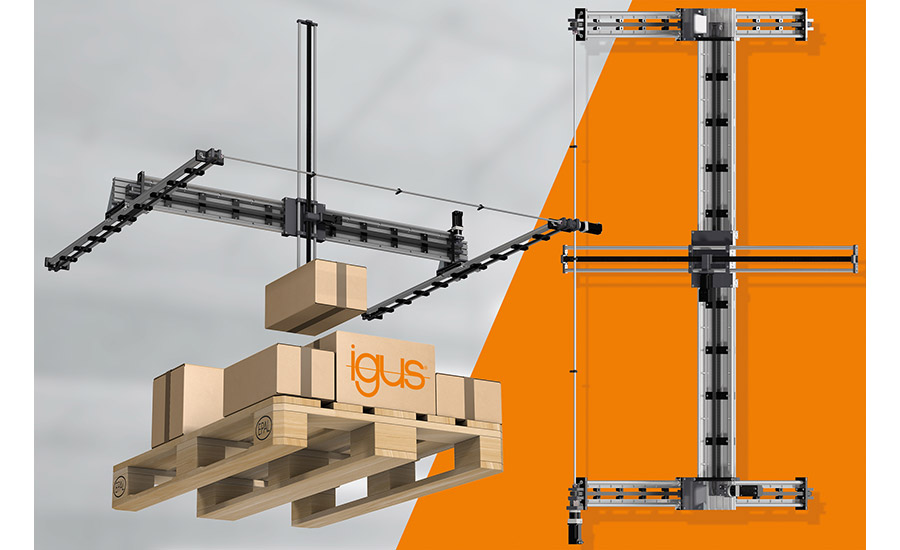
The new Drylin XXL gantry robot has a work envelope ranging from 2,000 by 2,000 by 1,500 millimeters to 6,000 by 6,000 by 1,500 millimeters. Photo courtesy igus
“Palletizing robots created in collaboration with external service providers cost between $95,000 and $135,000. This is beyond the budget of many small companies,” says Alexander Mühlens, head of the low-cost automation business unit at igus. “We have therefore developed a product that is many times more cost-effective due to the use of high-performance plastics and lightweight materials, such as aluminum. For example, the Drylin XXL robot costs between $7,000 and $10,000, depending on the expansion stage. It is a low-risk investment that usually pays off within a few weeks.”
The kit consists of two toothed-belt axes and a toothed rack cantilever axis with stepper motors. The package also includes the control system, cables and igus Robot Control (iRC) software. Engineers can assemble the components into a ready-to-use system in just a few hours. If additional components, such as camera systems or grippers, are needed, engineers can find them on the company’s robotics marketplace, RBTX.
The new robot is ideal for palletizing applications. For example, it can be positioned above a conveyor transporting parts away from injection-molding machines. The robot can pick parts from the conveyor, transport them at a speed of up to 500 millimeters per second, and position them on a pallet with a repeatability of 0.8 millimeter.
The system requires no maintenance. The linear axes are made from corrosion-resistant aluminum, and the carriages move via plain bearings made of high-performance Iglide plastics. The self-lubricating properties of the bearings enable low-friction, dry operation without external lubricants.
The iRC software enables simple and intuitive robot programming and control. “For many companies that don’t have in-house IT specialists, programming robots is often fraught with problems,” notes Mühlens. “That’s why we developed iRC, a free software application that visually resembles commonly used office software and allows intuitive programming of movements. What makes it special is that the software is free, and the resulting low-code programming can then be used 1-to-1 on the real robot.”
The core of the software is a 3D digital twin of the gantry robot, which can be used to define movements with just a few clicks.
“Prospective buyers can use the 3D model to check whether desired movements are actually feasible before making a purchase,” Mühlens says. “It makes the investment virtually risk-free.”
Plug-and-Play Cartesian
The BAIII Cartesian robot from TM Robotics is a plug-and-play system: All cables, junction boxes, brackets, motors and controllers are supplied with the linear actuators. This means there’s no need for calibration between the motor and the actuator or between the motor and the controller, which saves time and money and enables engineers to use the machine as soon as it’s installed.
The robot can be configured with one, two, three or four axes of motion. The length of the linear axes ranges from 50 to 4,450 millimeters.
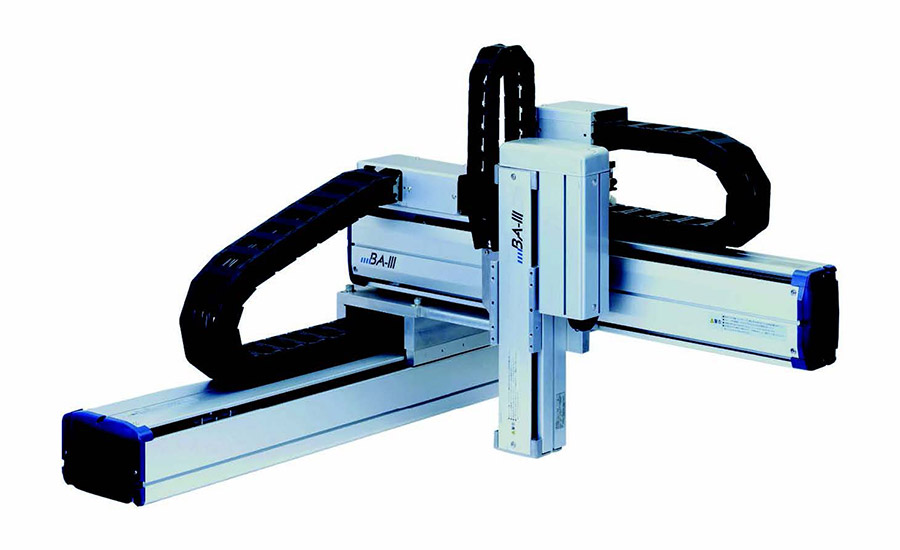
The BAIII Cartesian robot is a plug-and-play system: All cables, junction boxes, brackets, motors and controllers are supplied with the linear actuators. Photo courtesy TM Robotics
AC servomotors and absolute encoders are available in all models, which ensures accuracy and eliminates the need to perform a home-positioning routine. A two-axis model can carry a maximum payload of 100 kilograms and move at a maximum speed of 2,000 millimeters per second.
The robots can be shipped assembled for usage straight from the box. In addition, the actuators have oil-free bearings for minimal maintenance requirements.
“With this new Cartesian series, we’re seeing more capabilities being put into the hands of our customers, reducing their need to spend engineering time up front,” says Nigel Smith, CEO of TM Robotics.
Tabletop Cartesian for Dispensing
Nordson EFD’s GV Series of gantry robots for automated dispensing are equipped with DispenseMotion software and an integrated CCD smart vision camera or simple pencil camera to simplify setup and programming.
The CCD camera converts pixels into digital values to deliver precise, high-quality images. The proprietary dispensing software confirms workpiece presence and placement and automatically adjusts as in-process variations occur.
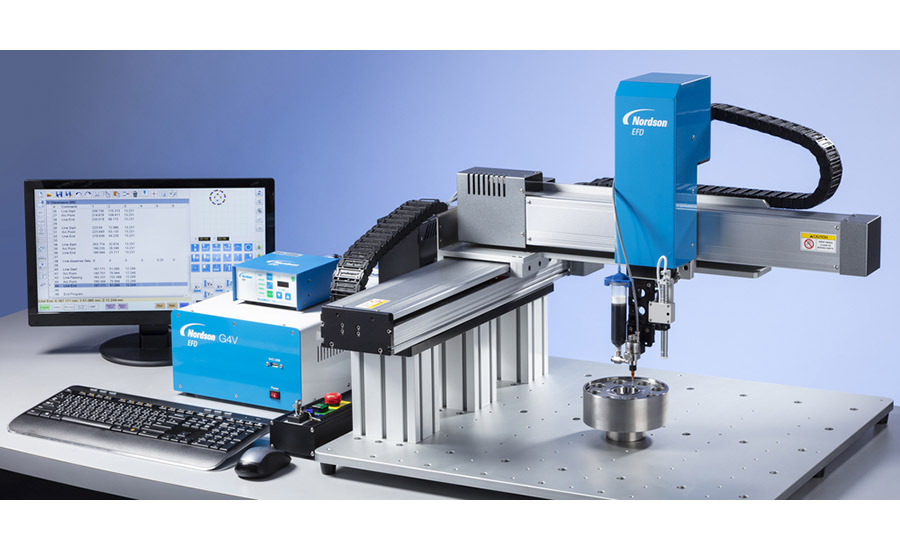
The GV Series of gantry robots for automated dispensing are equipped with DispenseMotion software and an integrated vision system to simplify setup and programming. Photo courtesy Nordson EFD
“With working envelopes that range from 400 to 800 millimeters and unlimited workpiece payloads, the GV Series is ideal for precision fluid dispensing onto substrates requiring large work envelopes without sacrificing repeatability,” says Johnathan Titone, product line specialist for automated dispensing systems at Nordson EFD. “It’s designed to work as a standalone system or an automated solution, and easily integrates into rotary tables or conveyer-fed automation.”
Other benefits of the system include highly accurate positioning and deposit placement repeatability of ±0.02 millimeter for the 400-millimeter robot and ±0.01 millimeter for the 800-millimeter robot.
ASSEMBLY ONLINE
For more information on Cartesian robots, read these articles:
Benchtop Dispensing Robots
Pint-sized Assemblers
Cartesian Robot Doubles Output of Solar Lego Modules


